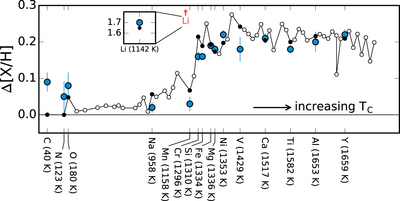Image Details

Caption: Figure 9.
Comparing the observed abundance difference (﹩\mathrm{Kronos}\mbox{--}\mathrm{Krios};﹩ blue circles) to the expected change in solar surface abundance after adding ﹩15\,{M}_{\oplus }﹩ of material with bulk Earth composition (McDonough 2003; black open and filled circles). The assumed mass fraction in the convective zone is 0.02. All astronomical metals are ordered by their ﹩{T}_{C}﹩ for solar-composition gas on the x-axis. For the predictions, we highlight elements measured for the Kronos–Krios pair as filled circles, while those without a measurement are left open. The close match with the observed abundance difference in the Kronos–Krios pair suggests that the abundance difference may be due to accretion of 15 ﹩{M}_{\oplus }﹩ of rocky planetary material. The element ﹩\mathrm{Li}﹩ is off the plot and indicated in the inset.
Copyright and Terms & Conditions
© 2018. The American Astronomical Society. All rights reserved.











